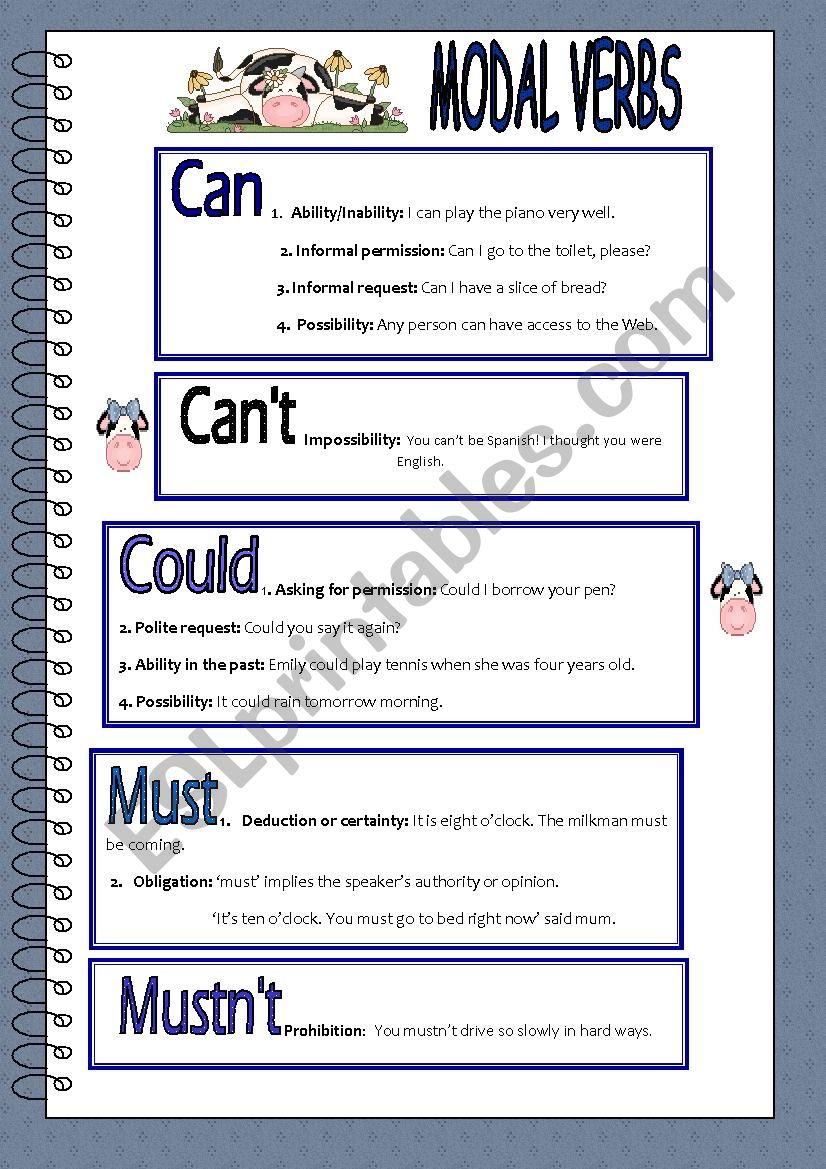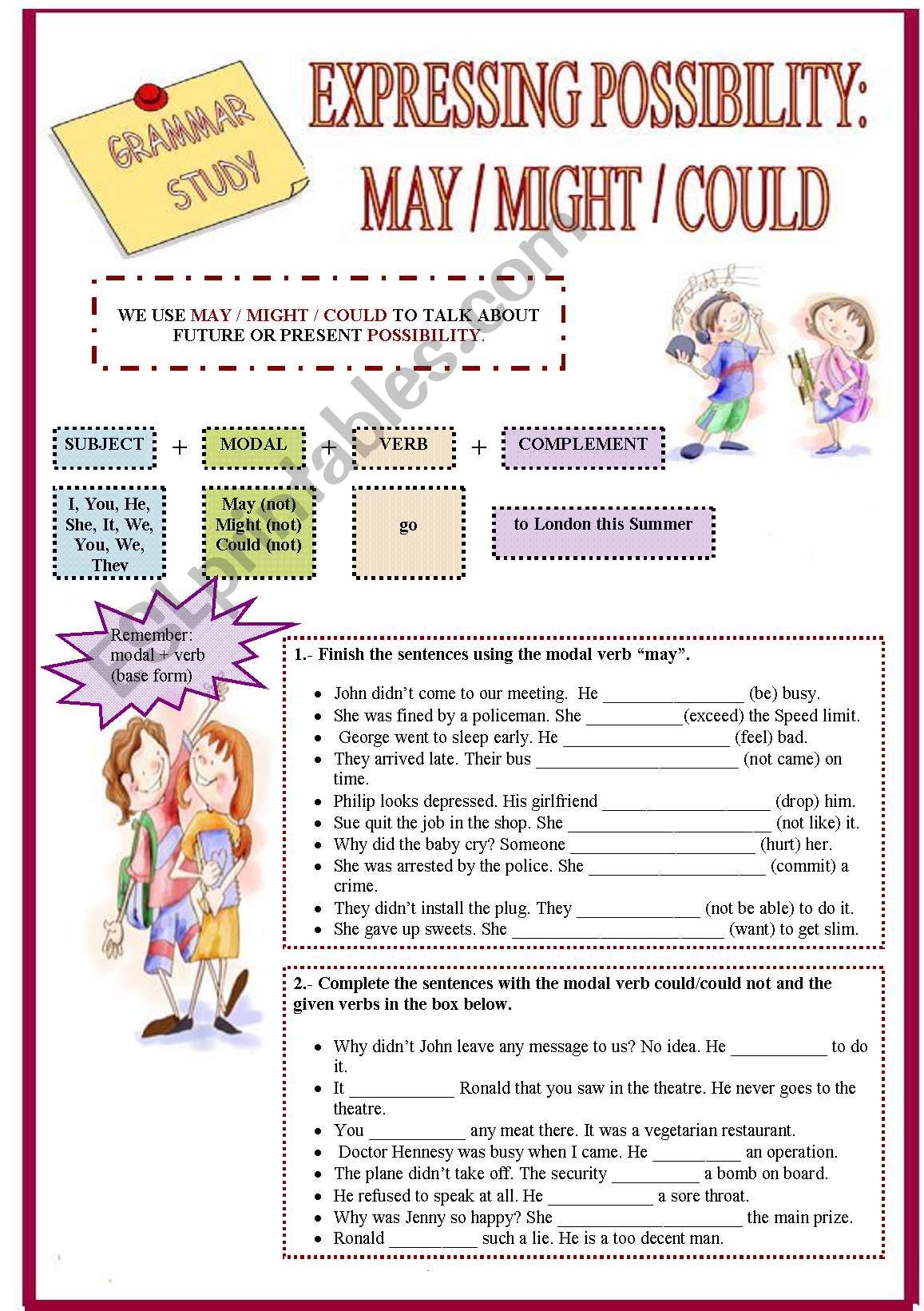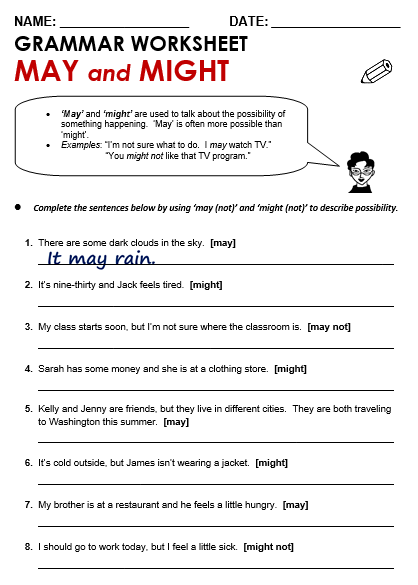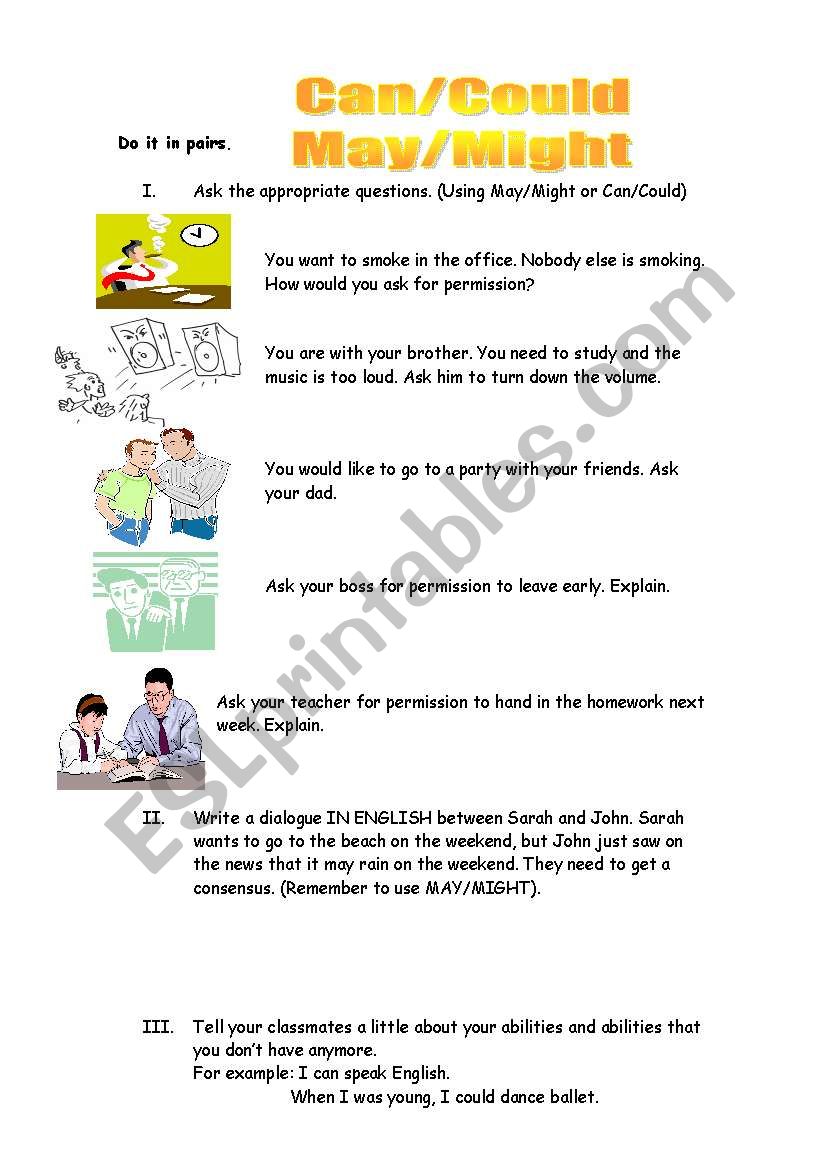
Mastering Nuance: The Essential Role of Modal Verbs Worksheets (Can, Could, May, Might, Must, Should, Would) in Language Learning
In the intricate tapestry of the English language, modal verbs stand out as indispensable tools for expressing a wide range of meanings, from possibility and permission to obligation and advice. Unlike regular verbs, modals do not change form, do not take "s" in the third person singular, and are always followed by the base form of another verb. Their subtlety and contextual dependency often pose significant challenges for language learners, making targeted practice crucial. This is where well-designed Modal verbs worksheets (can, could, may, might, must, should, would) become an invaluable resource, providing structured opportunities for students to grasp these nuances and apply them confidently.
The journey to English fluency is paved with understanding not just what words mean, but how they are used to convey specific intentions and attitudes. Modal verbs are at the heart of this expressive capacity. They allow speakers and writers to add layers of meaning to their statements, turning a simple declaration like "He go" into a nuanced expression like "He might go," "He should go," or "He must go." Each modal verb carries its own unique flavour, and mastering them is paramount for effective communication.
Understanding the Core Modal Verbs and Their Challenges

Let’s delve into the specific modal verbs that are typically the focus of comprehensive Modal verbs worksheets (can, could, may, might, must, should, would):

- Can: Expresses ability ("I can swim"), permission ("Can I go?"), or possibility ("It can get cold here").
- Could: Is the past form of ‘can’ for ability ("I could swim when I was young"), expresses polite requests ("Could you help me?"), or possibility ("It could rain tomorrow").
- May: Expresses permission ("You may enter") or possibility/probability ("She may be at home").
- Might: Expresses a weaker possibility than ‘may’ ("It might rain later"), or polite suggestions ("You might want to check that").
- Must: Expresses strong obligation/necessity ("You must finish your homework") or strong certainty/deduction ("He must be tired after that long flight").
- Should: Expresses advice/recommendation ("You should study more"), expectation ("They should be here by now"), or mild obligation ("We should arrive on time").
- Would: Used for conditional sentences ("If I were rich, I would travel"), polite requests/offers ("Would you like some tea?"), past habits ("When I was a child, I would play outside every day"), or reported speech.




The challenge for learners lies not only in understanding the primary meaning of each modal but also in distinguishing between similar modals (e.g., may vs. might for possibility, can vs. could for requests) and recognizing their multiple uses based on context. Furthermore, the lack of inflection and the fixed structure (modal + base verb) require consistent reinforcement to become second nature.

The Indispensable Role of Worksheets
Worksheets provide a structured, repeatable, and assessable way for students to engage with new grammar concepts. For modal verbs, they are particularly effective because they allow for:

- Targeted Practice: Each worksheet can focus on a single modal, a pair (e.g., can/could), or a specific function (e.g., modals of possibility). This allows learners to concentrate on one concept at a time before integrating them.
- Repetition and Reinforcement: The act of repeatedly completing exercises helps solidify the rules and common usages in the learner’s mind.
- Contextual Learning: Effective worksheets present modal verbs within realistic sentences and scenarios, helping students understand when and why a particular modal is used.
- Error Identification and Correction: Worksheets provide opportunities for students (and teachers) to identify common errors and address them directly.
- Self-Paced Learning: Students can work through worksheets at their own speed, allowing for deeper processing for some and quicker progression for others.
- Assessment: Worksheets serve as a valuable tool for teachers to gauge comprehension and identify areas where further instruction or practice is needed.

Designing Effective Modal Verbs Worksheets
Creating high-quality Modal verbs worksheets (can, could, may, might, must, should, would) requires thoughtful planning and an understanding of common learning challenges. Here are key considerations and exercise types:
-
Variety of Exercise Types:
- Fill-in-the-Blanks: The most common type, where students choose the correct modal from a given list or infer it from context.
- Example: "You ___ submit your application by Friday. (must/should/would)"
- Multiple Choice: Students select the best modal from several options.
- Example: "If I had more time, I ___ learn a new language. (can/would/must)"
- Sentence Completion: Students complete sentences using an appropriate modal and their own ideas.
- Example: "When I was younger, I ___ always ____."
- Sentence Transformation/Rewriting: Students rephrase sentences using a different modal to convey a specific meaning (e.g., change a statement of ability to a polite request).
- Example: "I am able to lift this box." -> "I ___ lift this box."
- Error Correction: Students identify and correct incorrect modal verb usage in sentences.
- Example: "You must to go now." -> "You must go now."
- Dialogue Completion/Role-Play Scenarios: Students fill in gaps in conversations or create their own dialogues using modals. This is excellent for practicing requests, offers, and advice.
- Example:
- A: "___ I borrow your pen?"
- B: "Yes, you ___. But please return it."
- Example:
- Matching Exercises: Matching a sentence containing a modal with the function it expresses (e.g., "You must wear a helmet" with "Obligation").
- Creative Writing Prompts: Asking students to write short paragraphs or stories using a certain number of specified modal verbs.
- Example: "Write about a future invention and what it could do, what people might use it for, and why they should have it."
- Fill-in-the-Blanks: The most common type, where students choose the correct modal from a given list or infer it from context.
-
Contextualization is Key: Avoid isolated sentences. Present modals within mini-dialogues, short paragraphs, or realistic scenarios (e.g., giving advice to a friend, discussing future plans, talking about rules at school). This helps students understand the social and pragmatic functions of modals.
-
Gradual Increase in Difficulty: Start with simpler, distinct modals (e.g., can for ability) before introducing more nuanced pairs (e.g., may/might for possibility) or multiple functions of a single modal. Begin with recognition tasks and move towards productive tasks.
-
Clear Instructions: Ensure that instructions are easy to understand and unambiguous. Provide an example if necessary.
-
Include Answer Keys: For self-study or peer-correction, answer keys are essential for immediate feedback, which is vital for learning.
Implementing Worksheets Effectively
Worksheets are most effective when integrated into a broader learning strategy:
- Pre-teaching and Explanation: Before students tackle a worksheet, explicitly teach the target modal verbs, their meanings, and typical structures. Use examples, visuals, and clear explanations.
- Guided Practice: Do the first few exercises of a worksheet together as a class or in small groups. This allows students to ask questions and clarifies expectations.
- Independent Practice: Allow students to complete the majority of the worksheet individually. This is where the real learning and reinforcement happen.
- Feedback and Correction: Go over the answers together. Encourage students to explain why they chose a particular modal. Address common errors and provide constructive feedback. Don’t just give the right answer; explain why it’s right.
- Follow-up Activities: Worksheets can be a springboard for speaking or writing activities. For example, after a worksheet on should for advice, have students give advice to fictional characters or write an advice column.
The Broader Benefits of Consistent Practice
Consistent engagement with Modal verbs worksheets (can, could, may, might, must, should, would) yields significant benefits beyond just grammatical accuracy:
- Improved Fluency and Naturalness: As modal verbs become second nature, learners can express themselves more smoothly and naturally, reducing hesitation.
- Enhanced Comprehension: Understanding the subtle meanings conveyed by modals helps learners better interpret spoken and written English, including academic texts, news articles, and everyday conversations.
- Increased Confidence: Successfully navigating the complexities of modal verbs boosts a learner’s overall confidence in using English.
- Preparation for Standardized Tests: Many English proficiency tests (e.g., TOEFL, IELTS, Cambridge Exams) include sections that specifically test modal verb usage, making worksheet practice invaluable for preparation.
- Development of Critical Thinking: Choosing the most appropriate modal often requires careful consideration of context, intent, and nuance, thereby sharpening critical thinking skills.
In conclusion, modal verbs are the unsung heroes of English expression, allowing speakers to convey shades of meaning that would otherwise be impossible. For educators and self-learners alike, Modal verbs worksheets (can, could, may, might, must, should, would) are not just supplementary materials; they are foundational tools. They provide the necessary structured practice, contextual exposure, and immediate feedback required to transform a theoretical understanding of these crucial grammatical elements into confident, natural, and effective communication. Investing time in creating and utilizing high-quality worksheets is an investment in linguistic mastery.
